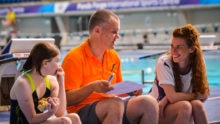
Tips for writing a CV
January 27, 2016 Careers AdviceWriting a CV is a skill and one you should learn. A good CV can make or break your chances of getting an interview. A poorly written CV could prevent you from securing that dream job.
Here are a few simple tips to follow when writing a CV to help ensure your CV stands out from the crowd and provides the best representation of what you can offer.
Writing a CV: where to start
Before you start writing a CV have a long think about what information you are going to include. It needs to be a document marketing the very best of you.
Write down the 10 top achievements of your career then the skills you used to realise them. These achievements are what make you unique and separate you from other people with similar qualifications.
Here are a few ideas to get the creative juices flowing before writing a CV:
Swimming Teacher
- Swim England Learn to Swim Programme – you should know all about the Programme . Find out more about it here.
- Teaching different people – when writing a CV gather your thoughts on how you would approach teaching different groups such as children, adults, disabled children, school groups, big groups v small groups. Any particular ways you have learnt to control a large group of children, for example.
- Lessons learned – it’s a good idea to be able to talk positively about your own personal development. You will have learned lessons and ideas from other teachers over the years. State what these were and how you have developed them.
- Games and activities – when writing a CV think about your favourite games and activities for helping people to learn on different stages of the Learn to Swim Programme and why are they so good.
- More than swimming – stages eight, nine and 10 of the Swim England Aquatic Skills Framework involve introductions to other aquatic disciplines of diving, synchro and water polo as well as rookie lifesaving skills.
Swimming Coach
- Achievements are slightly more quantifiable with coaches – number of national qualifiers, number of medals, number of swimmers at the club etc. While these always sound great and you should definitely include them, most people applying for the job of swimming coach will have similar stats. So when writing a CV prepare some more achievements outside the obvious.
- Working with specific swimmers – the relationship between swimmer and coach can be a tricky one to maintain, especially with some children. Have you worked hard to develop a good relationship with any particular swimmers? What challenges did you have to overcome and how did you do it?
- Volunteers – when writing a CV for a coach it helps if you show how you have worked with volunteers. They’re the lifeblood of most swimming clubs, arguably of aquatics in general. Think about how have you worked with volunteers at previous jobs for the benefit of the club in general.
Lifeguard
- If you’ve intervened and saved someone from drowning, it’s fine to include this as an achievement but also to talk about what happened afterwards. Why did the person get into difficulty? What steps did you take? Did you suggest changes to the centre managers so this wouldn’t happen again?
- Talking about working with the management of the centre to improve safety shows initiative and enthusiasm.
Once that’s done, take a look at the job description for the role you are applying for. When writing a CV it should be written to suit the job.
Just as you hate receiving an impersonal group text or e-mail, employers hate receiving a generic CV, not tailored for their specific role. When writing a CV take time to tweak it to impress them specifically.
Laying out your CV
When writing a CV there are a number of CV templates available online you could use as a basis.
The most common and safest design is to split your CV into the following section:
- Contact Details
- Personal Statement
- Employment History
- Training / qualifications
- Education
- Interests
- Reference Area
This layout means the information is listed in order of importance and relevance for the reader.
Contact Details
When writing a CV begin with contact details at the top. Make it as easy as possible for people to contact you. Include name, address, e-mail address, home phone number, mobile phone number.
It’s becoming more common for people to include digital contact details as well including links to LinkedIn or Twitter profiles. If you do this, ensure there is nothing you wouldn’t want your employer to see on these profiles
Personal Statement
Give a brief outline of your career to date and what you are looking to achieve in the future. It should only be a few lines emphasising how suitable you would be for the role you are applying for. It’s another good chance to show you’ve researched the company as well.
Employment History
Create a reverse-chronological list of work experience. For each job, list the job title, the dates you were in that job, the name of the organization and one sentence summarizing the responsibilities of the role.
For your previous jobs relevant to the one you are applying for, create a bullet point list of some of your best achievements within that job (refer to your achievement list you created earlier), indicating the skills used for each.
When writing a CV remember to think which jobs are the most relevant for the role. Don’t waste space putting achievements for jobs unrelated to the one you are applying for. Also, don’t include jobs from more than 10 years ago unless they are relevant to the one you are applying for.
If there are significant gaps in between jobs (more than six months), include this time and put a sentence explaining why there is a gap and what you were doing during this time to further your career.
When writing a CV it is also worth creating a separate section for any voluntary work you’ve done if it is relevant (anything showing an experience of working within sport for example).
Training / Qualifications
Have you had any official training or qualifications relevant to the job you are applying for? Here is the place to put them. List the full qualification and when you took it.
Education
Unless your employment history and qualifications are particularly sparse, there’s no need to include too many details in your education section when writing CV. Just a list of your A-levels and GCSE’s will do as well as dates you took them and where.
If you are a recent school leaver and don’t have much to include in employment history and qualifications, you can include some achievements in this section which you think would be relevant to the role you are applying for.
Interests
It’s the least important section of the CV which is why it is at the bottom! If there’s anything else you think would be useful to include, write it here.
References
When writing a CV don’t waste valuable space with full addresses for any references (unless they are specifically requested). Just put references are available on request.
Presenting your CV
The key to remember is keep it short and snappy. Nobody will trawl through a long CV – remember that they are scanned rather than read.
An absolute maximum is two A4 pages of a Microsoft Word document – and that doesn’t mean shrinking the font size and cramming in lots of paragraphs of prose!
Just like a tasty meal, the sight of the CV should whet the appetite – include plenty of white space on the page, use a standard font such as Times New Roman or Arial and a clear font size. Headers and bullet points will help the reader find information easily while you should avoid large paragraphs of text.
If you have to be selective, think of it as a good thing that you’ve got so much you can impress the reader with!
Finally, give your CV a proper proofread. Formatting and spelling checks on Word will help but might not catch everything – print it out and give it to friends and family for them to have a read.
 Careers in Aquatics
Careers in Aquatics



